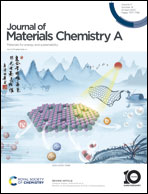3D nanoflower-like and core–shell structured MCo2O4@MCo2S4@polypyrrole (M = Cu, Mn) composites as supercapacitor electrode materials with ultrahigh specific capacitances†
Abstract
Herein, we synthesize 3D nanoflower-like MCo2O4@MCo2S4@polypyrrole (M = Cu, Mn) core–shell composites on nickel foam (NF). CuCo2O4 (CuC) and MnCo2O4 (MnC) nanowires and CuCo2S4 (CuS) and MnCo2S4 (MnS) nanosheets grow vertically on NF as the core by hydrothermal and calcination methods and a PPy film covered on the surface of MCo2O4@MCo2S4 (M = Cu, Mn) as the shell via a chemical bath method to form 3D self-supporting nanoflower-like composite materials. The as-prepared MC@MS@PPy-16/NF (M = Cu, Mn) electrode materials are characterized by field emission scanning electron microscopy (FESEM), transmission electron microscopy (TEM), high-resolution transmission electron microscopy (HRTEM), X-ray diffraction (XRD) and X-ray photoelectron spectroscopy (XPS). Due to the particularity of the electrode material structure, the MC@MS@PPy-16 (M = Cu, Mn) electrode has a high specific capacitance (Cs, 413.63 mA h g−1 and 654.64 mA h g−1 at 1 A g−1) and the Cs retention rate exceeds 90% after 10 000 cycles. The asymmetric supercapacitor (ASC) device assembled with the MC@MS@PPy-16 (M = Cu, Mn) electrode as the positive electrode, active carbon (AC) as the negative electrode and 6 M KOH as the electrolyte can work stably in a broad voltage range of 0–1.6 V. MC@MS@PPy-16//AC ASC (M = Cu, Mn) devices display excellent electrical characteristics in terms of high energy density (41.34 and 38.75 W h kg−1 at 8000 W kg−1) and cycling stability (Cs retention rates of 84.74% and 80.4% and coulombic efficiencies of 80.15% and 83.69%). These results show that MCo2O4@MCo2S4@polypyrrole composite materials have great application potential in high-performance supercapacitors.



 Please wait while we load your content...
Please wait while we load your content...